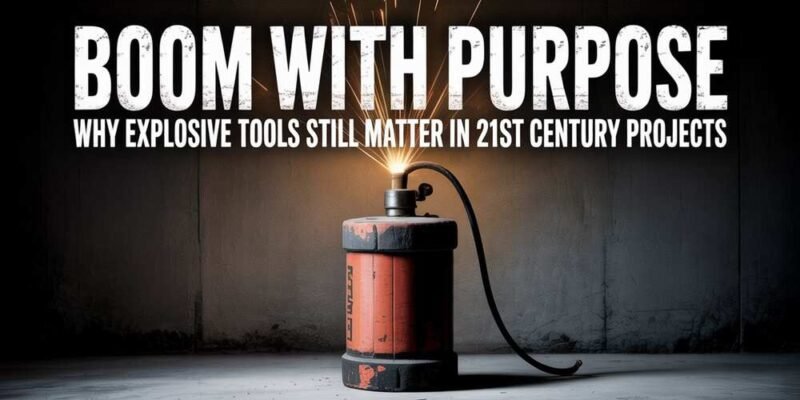Regular tools can’t keep up in big jobs like breaking rocks or clearing land. That’s where dynamite tools step in. These explosive tools are made for serious work, like digging deep into mountains, knocking down buildings, or helping with mining. While they sound dangerous, they’re super helpful and save time with the proper planning and safety.
This article breaks down where dynamite tools are used, what problems they solve, and how people use them safely.
The Role of Dynamite Tools in Heavy Work
Common Problems with Manual Methods
Using essential tools to break large rocks or remove old buildings takes time and energy. Workers might spend days doing something that dynamite can do in minutes. This delay can slow down the whole project and cost more money.
How Dynamite Tools Speed Up Work
Dynamite tools break apart rigid material fast. In mining, they help reach deep layers of coal, iron, or gold. In building projects, they clear the land quickly so construction can begin. Their power makes complex jobs easier and faster.
Safety and Precaution in Handling
The Risks of Using Explosives
Things can go very wrong if someone doesn’t know how to use dynamite tools. Failure to follow proper steps can lead to injury or even significant accidents. Explosives must be handled by trained people who know all the rules.
Safety Measures That Work
Wearing protective gear, setting up warning zones, and using remote triggers are innovative ways to stay safe. Explosive experts must always follow rules from groups like OSHA or ATF in the U.S. These rules keep workers and the nearby public out of harm’s way.
Solving Mining and Digging Challenges
Old-School Mining Tools and Their Limits
Before dynamite, miners used picks and drills. These tools worked but were slow and couldn’t reach deep pockets of minerals or gems. That made mining take longer and cost more.
Controlled Blasting for Better Results
With controlled blasting, workers can dig deep without tearing up the whole area. This method targets only where needed, protecting the surrounding land and helping find what’s underground faster.
Dynamite Tools and the Environment
Blasting and Its Impact on Nature
Some worry that blasting harms plants, animals, and the soil. If not done right, it can damage the land and make it hard for things to grow back. Noise and dust can also upset nearby wildlife.
Making It More Eco-Friendly
Today, crews use low-impact charges and plan their work to reduce harm. They even plant trees or fix the land after work is done. Blasting isn’t perfect, but innovative steps make it more nature-friendly.
Training for the Job
Why Untrained Use Is Dangerous
Letting someone use dynamite without training is like giving a car to someone who’s never driven. They may not know how to light it, where to stand, or how to handle misfires. Mistakes can cause big trouble.
Learning to Use Dynamite the Right Way
People who use dynamite tools need special classes and tests. In the U.S., they must get a blaster’s license. This proves they know what they’re doing and helps avoid accidents.
Working in Hard-to-Reach Areas
Problems with Rough Terrain
Sometimes, land is full of rocks, hills, or thick trees. Using big machines isn’t always possible there. Tools break, or workers can’t even reach the area.
Why Explosives Are a Smart Fix
In these cases, dynamite tools can get the job done. A single blast can clear a path, open up rock, or level ground, making it easier for trucks or tools to move in.
Dynamite in Urban Projects
Clearing Old Buildings Safely
In cities, tearing down old buildings can be tricky. Regular machines can’t always work in tight spots, and falling walls or dust can be problematic.
How Precision Blasting Helps
Using controlled demolition with dynamite makes this safer. The blast is planned to bring the building down neatly. Experts know how to place charges so that only the building falls, not nearby homes or roads.
Emergency Use of Explosive Tools
Dealing with Blocked Paths
Roads and rail lines can get blocked after a landslide, avalanche, or big storm. Sometimes rocks or debris are too big to move.
When Blasting Clears the Way
With proper permission, experts use dynamite tools to break these barriers. This opens up roads for rescue crews or travelers. It’s one of the fastest ways to make paths safe again.
Conclusion
Dynamite tools might sound dangerous, but they solve many big problems correctly. From breaking rocks to clearing buildings, they save time and energy. They work in hard places and help with jobs that regular tools can’t handle.
Safety, training, and planning are key. With these in place, blasting becomes less about risk and more about innovative work. As long as explosive tools are in the right hands, they’re a powerful part of building, digging, and moving forward.













